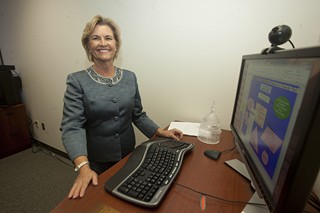Your Word Is Your Bond
Travis County moves toward broader pretrial release of the accused. Commercial bondsmen say it will never work.
By Jordan Smith, Fri., Oct. 12, 2012
It's just before 9:30am when Austin municipal Judge Ron Meyerson dons his black robe and heads through a remotely locked door into a cinder-block-walled courtroom tucked into a basement corner of the Travis County Jail. This is the magistrate court, where the newly arrested are brought in a group for their first meeting with a judge.
Meyerson takes his seat, above rows of chairs filled with more than two dozen men and women dressed in gray stripes and locked together in pairs with pink handcuffs, and delivers a speech he's honed to near perfection during nearly two decades on the job. You're being held in jail, he begins, because you've been charged with a crime. You have not been convicted and are presumed innocent.
As usual, this morning's charges run the gamut – from a hungover, college-age guy on a public intoxication charge, to a man held on two counts of second-degree aggravated assault after an alleged attack with a tire iron. Meyerson calls each name in turn, reads aloud the pending charges and asks three questions: Do you understand? Do you have any questions? Do you need a court-appointed attorney? Everyone says they understand; three people have questions; about half request appointed counsel.
Meyerson is among six full-time municipal judges who act as gatekeepers for the county's criminal justice system. It's a job he loves and takes very seriously. "I screen cases for probable cause; I release people," he says. Importantly, Meyerson sets bail, and explains to the defendants before him the four legal ways they can get out of jail: by posting the total amount of bail in cash; by contracting with a bail bondsman, typically paying a percentage of the bail amount; by hiring an attorney; or by being approved for a personal bond.
Ultimately, if the 26 people sitting in front of Meyerson this Friday morning in mid-August are typical of the tens of thousands of defendants who enter the county's criminal justice system each year, many of them will use one of these avenues to get out of jail while the charges against them are pending. The "pretrial" period typically spans several months, but depending on the charge, it can at times extend into years. And many of these defendants, perhaps the majority, are likely to qualify for a personal bond – meaning they'll be judged a good risk to go home on a promise to return to court when scheduled, and to avoid being arrested until the pending charges can be adjudicated.
Who Gets Out?
Legally speaking, the only factors that can be considered when setting bail are a defendant's flight risk – which affects the administration of justice – and whether that person, if released, would pose a threat to public safety while awaiting adjudication. Deciding who will return to court and won't commit any additional crimes in the interim is, to varying degrees, a guessing game. Historically, money has been used as an admittedly imperfect hedge against risk. Defendants who can't make bail – even a portion of it, even on a first-time offense or on the most minor of charges – can wind up sitting in jail until their cases are resolved, at great cost to themselves and to taxpayers.
As of Sept. 1, nearly half of the more than 67,000 jail inmates statewide were being detained pretrial. In 2010 alone, pretrial detainees cost U.S. taxpayers roughly $9 billion, according to the American Bar Association – and that figure does not address the collateral damage to defendants and their families.
In Travis County, court officials say they're working hard to make pretrial detention the exception and not the rule. Dr. Geraldine Nagy is director of the county's adult probation and pretrial services department; if a plan she devised succeeds this fall as planned, the number of defendants released on personal bond, with or without ongoing direct supervision, may increase – while still ensuring court appearances, maintaining public safety, and in theory saving the county millions. In fact, Nagy would like to see the Travis County system for pretrial release and supervision become a jewel of the county's criminal justice system and a model for the state in saving money, effectively managing risk, and encouraging just outcomes.
"You don't want to become a bleeding heart and have people out in the community who need not be out," Nagy says. "That's not the deal. What you want to do is be able to sort through and effectively determine who should be out in the community. There is an opportunity here for justice that is greater than at any other point in the process."
But Nagy's enthusiasm for the expansion of personal-bond pretrial release services is not shared by everyone – least of all by those in the state's commercial bail industry. Industry advocates argue that pretrial release agencies pose a public safety risk, because they release thousands of people who have no real skin in the game. The bondsmen say the money put up by defendants and their families does a better job of ensuring that defendants appear in court and stay out of trouble than does any promise made to a pretrial release agency.
Moreover, bondsmen see attempts to expand pretrial service agencies as a grave threat not only to public safety but also to their financial survival – and they're not going down without a fight.
Who Stays In?
The Eighth Amendment to the U.S. Constitution explicitly bans the imposition of excessive bail – though where that line is drawn is a matter of debate. Except in limited circumstances, the Texas Constitution follows suit, mandating that bail will be set for "all prisoners." In fact, asserts Ken Good, a Tyler attorney and the Texas counsel for Allegheny Casualty, International Fidelity and Associated Bond (AIA), a major player in the insurance-backed bail bond industry, the Texas Constitution goes further than just ensuring bail is set. Defendants "shall be bailable by sufficient sureties," reads the text – a detail that Good says is key to understanding the landscape of pretrial release in Texas. "I think our Texas Constitution was written on a basis of private [monetary] bail," he says, not on a get-out-of-jail-free card.
The time-hallowed concept of money bonds is simple. A person is arrested – say, on a misdemeanor marijuana possession beef – and bail is set at $1,000. The defendant doesn't have the grand in cash – nor does his family or friends – but together they can come up with $100, 10% of the total amount. A bondsman accepts that $100 as a promise on the $1,000 (on larger bail amounts, collateral is often required), and the bondsman secures the defendant's release. If the defendant makes every court appointment and avoids arrest until the case is resolved, he'll remain out of jail, the bondsman will keep the $100, and no one will have to pay the remaining $900. It is a simple system that benefits both defendants and government, bail industry advocates say.
But it isn't perfect. Not everybody can find the cash to hire a bondsman, advocates of personal bond services counter, and the cost of housing defendants who haven't been convicted of anything is high. In Travis County it costs $105.61 per inmate per day, according to Sheriff's Office spokesman Roger Wade; as of Sept. 1, according to the Texas Commission on Jail Standards, there were 1,292 pretrial defendants (56% of the jail population) sitting in the county jail, at a single-day cost of $136,448.
Indeed, it was in part jail overcrowding that led to the rise of pretrial services agencies. Judges had the power to grant personal bonds – that is, solely on the personal promise of the accused to appear in court – but in Texas' politicized and partisan judicial landscape, judges are often wary of the risk of releasing a person who could possibly hurt someone while out awaiting trial. From the combination of judicial nervousness and pressure (often court-ordered) to reduce jail populations, Texas' pretrial service agencies were born. While the agency model differs from county to county (some do without), Travis County's program is widely considered one of the most robust personal bond offices in the state, both by supporters of personal bond release and by critics in the commercial bail industry. To former district Judge Charlie Baird, personal bond is an important part of the pretrial landscape. "It allows people who are presumptively innocent to get out and not just to continue to work, to provide for themselves and their families, and to help their lawyers prepare a case, but it also saves the county millions a year," he says.
In 2010, Nagy's pretrial services staff screened more than 40,000 defendants in the Travis County jail, to determine who might be eligible for a personal bond. Only a discrete class of defendants is automatically ineligible – including those charged with capital crimes and those who've violated parole or forfeited a previous bond. In all, roughly 32,000 of those screened made it to a full-fledged pretrial investigation, for which staff collects references, conducts a background check, and considers a variety of issues – including employment status and family support – that might suggest whether a defendant will show for court or be rearrested. The agency then makes a recommendation to the courts about whether the person should be granted a personal bond. In 2010, 63% of defendants released pretrial were released on personal bond. That same year the agency posted a court failure-to-appear rate of 13% and a rearrest rate of 14%, according to annual reports the agency is required to file. In contrast, that same year defendants released on commercial bond failed to appear in court 20% of the time, according to information collected by Travis County.
Nagy believes the FTA and rearrest numbers will shrink with the introduction in November of a research-based risk-assessment tool, designed and validated specifically for Travis County defendants, in order to help her staff more objectively determine a person's likelihood of success if released on personal bond. "That's really consistent with all the research on decision-making. ... These tools do significantly better than just the person" making a decision, Nagy says. "Making a pretrial decision without risk assessment is like playing golf in the fog."
Considered a "best practice" nationwide, the use of research-based, locally validated assessments that group defendants into low-, medium-, and high-risk categories is still relatively rare. In a recent survey of agencies across the state, the Texas Criminal Justice Coalition found just two – Travis and Harris Counties – that said they are using a validated risk assessment tool. Nagy is a firm believer that using a RA tool will improve public safety and positively affect defendants' lives. She says she'd love to see "every community have a strong pretrial services program" using validated risk assessment, and she hopes Travis County can help lead the way in Texas. Science, she says, is on her side.
The Right Questions
Nagy began her career as a probation officer in Bastrop, and did statewide and national work on probation issues before returning to Travis County about eight years ago to run the county's probation department. She's since turned that program into a nationally recognized model, in part for her use of validated risk tools to effectively determine how to manage the thousands of probationers who enter the system each year.
While remodeling the county's probation department, Nagy resolved to do the same for pretrial services. Her staff tracked the experiences and case outcomes of more than 1,000 county defendants over a period of 2½ years. That data was analyzed by Ed Latessa, director of the Division of Criminal Justice at the University of Cincinnati, and was returned to Nagy in the form of a seven-question survey. With weighted answers, the seven questions can effectively rank people by their level of risk to abscond or be rearrested. That information in turn helps Nagy's staff – and ultimately the judges to whom they report – to decide who should be released on personal bond. "You get a score, and based on that score, you're classed into one of three groups. And based on the data, each of those three groups has a level of recidivism," explains Nagy. Low-risk people, without complicating factors, are mostly likely to be released without any conditions – and Nagy suspects that with the new risk tool, more low-risk Travis County defendants will be released from jail on a personal promise to stay straight and fly right. Defendants in the medium- and high-risk groups may still qualify for personal bond release, but likely with additional restrictions – like GPS monitoring, drug testing, daily calls to a case manager, or even house arrest. Of the more than 19,000 defendants released on personal bond last year, 6,890 were released with some sort of restriction.
While Nagy's staff has long used a more intuitive battery of questions to categorize defendants, the new analytical tool is designed to help Nagy's staff ask the right – and more reliably predictive – questions of defendants. Do you have a job? Housing? Have you failed to appear in court before? Do you have a substance abuse problem? At the same time, several long-used considerations are no longer used – including whether the person has lived in Travis County for more than a year, and the nature of the criminal charge. As it turns out, with the exception of four charges (murder, rape, robbery, and car theft), the offense a person is charged with is not predictive of future behavior. But the age at which a person was first arrested is in fact "a very high predictor of recidivism in any setting," says Nagy. "The younger a person is arrested in life, the riskier they are. It's one of the most sound predictors of recidivism." Latessa says that recommendations for release based on the validated risk assessment take subjectivity out of the decision-making process and place it in the hands of the science. "The tool is neutral; it doesn't care if you're rich or poor, black or white," he says.
What is not a predictor, surprisingly, and what is not asked about on any valid RA tool, experts say, is whether a person has, or has access to, money. "What's happened is the attachment to money bond in our culture [leads] some people to think that money has some" correlation to risk, says Nagy. "And it absolutely doesn't."
Got something to say on the subject? Send a letter to the editor.












